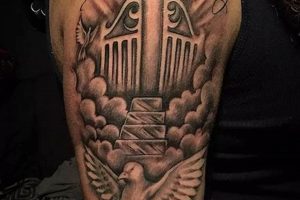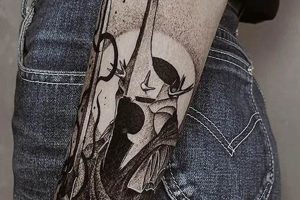Classic designs drawn from established visual vocabularies characterize this style of body art. Common motifs include anchors, roses, eagles, and nautical stars, often rendered with bold lines, vibrant colors, and minimal shading. These designs frequently draw inspiration from various historical and cultural sources, such as American folk art, Japanese woodblock prints, and 19th-century maritime imagery.
The enduring appeal of this tattoo aesthetic stems from its timeless quality and symbolic richness. Bold imagery conveys strength, resilience, and connection to shared cultural narratives. The simplified color palettes and strong outlines ensure designs remain visually striking over time, aging gracefully with the wearer. These enduring qualities contribute to the continued relevance of this form of artistic expression in contemporary tattoo culture.
This exploration delves further into specific design elements, their historical significance, and the cultural contexts that have shaped this enduringly popular artistic tradition.
1. Bold Lines
Bold lines form the backbone of traditional tattoo aesthetics, contributing significantly to their distinctive visual impact and longevity. Their prominence is not merely stylistic; it serves practical and artistic purposes integral to the tradition.
- Definition and Visual Impact
These lines, characterized by their clean, consistent thickness, create a graphic and powerful impression. They define the boundaries of the design elements, ensuring clarity and separation between colors. This strong visual presence makes the tattoo stand out and remain legible over time.
- Durability and Aging
Thick, solid lines hold their shape better than fine lines as the tattoo ages. The ink particles in broader lines are less susceptible to dispersion within the skin, a natural process that can blur finer details over years. This characteristic ensures the tattoo remains recognizable and aesthetically pleasing even as it matures on the skin.
- Historical Context and Technique
The historical tools and techniques used in traditional tattooing contributed to the development of this bold line style. Early tattoo machines and needles were less precise than modern equipment, making consistent thick lines easier to achieve and more practical. This technical limitation shaped the aesthetic that has become a hallmark of the style.
- Symbolic Significance
Beyond their practical function, bold lines can also contribute to the symbolic weight of a tattoo. They convey a sense of strength, permanence, and decisiveness, mirroring the themes often explored in traditional tattoo imagery. The unwavering lines can represent resilience, commitment, and the enduring nature of the chosen design.
The bold lines of traditional tattoos are thus more than a mere stylistic choice. They are a fundamental element that contributes to the visual impact, longevity, historical context, and symbolic meaning of these enduring designs. Their presence reinforces the timeless quality and powerful expression inherent in this art form.
2. Vibrant Colors
Color plays a crucial role in the aesthetic impact and symbolic meaning of traditional tattoos. The specific palette employed contributes significantly to the timeless quality and recognizability of these designs. Understanding the selection and application of these colors provides deeper insight into this enduring art form.
- Limited Palette
Traditional tattooing utilizes a select range of bold, solid colors. Common choices include black, red, yellow, green, and blue. This limited palette contributes to the visual clarity and graphic impact of the designs, ensuring they remain vibrant and legible over time. Restricting the color range also facilitates a cohesive aesthetic that distinguishes traditional tattoos from other styles.
- Symbolic Meanings
The colors used in traditional tattooing often carry symbolic weight, adding layers of meaning to the imagery. Red can represent passion, love, or sacrifice; yellow can symbolize joy, prosperity, or caution; green can signify luck, nature, or jealousy. These color associations enhance the narrative potential of the designs, allowing for more complex and personalized expressions.
- Contrast and Impact
The bold colors used in traditional tattooing create strong contrast, enhancing the visibility and impact of the designs. The juxtaposition of saturated hues against the skin or other colors creates a dynamic visual effect that draws the eye and emphasizes the graphic quality of the artwork. This emphasis on contrast contributes to the timeless appeal of these designs.
- Pigment Quality and Longevity
Historically, the pigments used in traditional tattooing were formulated for maximum vibrancy and longevity. These pigments were designed to withstand the test of time, minimizing fading and ensuring the tattoo remained legible and aesthetically pleasing for years to come. This focus on pigment quality contributed to the enduring nature of traditional tattoos and their ability to age gracefully.
The vibrant, carefully chosen colors of traditional tattoos are integral to their overall aesthetic and symbolic power. From the limited palette to the symbolic associations and the emphasis on contrast and longevity, color plays a crucial role in defining this enduring art form and contributing to its timeless appeal.
3. Iconic Imagery
Specific visual motifs define traditional tattooing, carrying symbolic weight and historical significance. These iconic images, often drawn from maritime culture, folklore, and mythology, contribute to the enduring appeal and rich narrative potential of this art form. Understanding these recurring symbols provides a deeper appreciation for the cultural context and artistic heritage embedded within traditional tattoo designs.
- Nautical Motifs
Anchors, ships, swallows, and nautical stars are prevalent in traditional tattooing, reflecting the historical connection to seafaring culture. Anchors symbolize stability and hope, while swallows represent safe passage and return home. Ships embody adventure and exploration, and nautical stars signify guidance and protection. These maritime symbols evoke a sense of wanderlust, resilience, and connection to the sea.
- Animals and Birds
Eagles, panthers, snakes, and tigers feature prominently, each carrying specific symbolic connotations. Eagles represent freedom and power, panthers symbolize stealth and protection, snakes embody transformation and healing, and tigers signify strength and courage. These animalistic representations often embody primal instincts and powerful archetypes.
- Floral Elements
Roses, daggers, and cherries are common floral motifs, often interwoven with other imagery. Roses symbolize love, beauty, and passion, while daggers represent danger, loss, or remembrance. Cherries signify sweetness, innocence, or the fleeting nature of life. These floral elements add layers of meaning and visual interest to traditional tattoo designs.
- Symbolic Objects
Skulls, hearts, and dice are recurring symbolic objects in traditional tattoos. Skulls represent mortality and the acceptance of death, hearts symbolize love, devotion, and emotional strength, and dice represent risk, chance, and fate. These symbolic objects add depth and philosophical weight to the chosen imagery.
The iconic imagery of traditional tattooing draws from a rich tapestry of cultural and historical sources, creating a visual language that resonates with both artist and wearer. These powerful symbols, imbued with layers of meaning, contribute to the enduring popularity and narrative richness of this distinctive art form. Recognizing these recurring motifs allows for a deeper understanding of the symbolic power and cultural heritage embedded within each design.
4. Cultural Significance
Cultural significance plays a vital role in shaping the imagery and enduring appeal of traditional tattoo designs. These designs are not merely aesthetic choices; they often carry deep-seated cultural meanings rooted in history, folklore, and shared human experiences. Understanding this cultural context provides a richer appreciation for the artistry and symbolic power of traditional tattoos.
- Maritime Heritage
Traditional tattooing has strong ties to maritime history, particularly the cultures of sailors and dockworkers. Many iconic motifs, such as anchors, swallows, and ships, originated within these communities. Anchors symbolized hope and steadfastness, swallows represented safe passage and return home, and ships embodied adventure and exploration. These designs served as markers of identity, shared experiences, and talismans of good fortune within maritime culture.
- Indigenous Influences
Various indigenous cultures worldwide have long-standing traditions of body art, some of which have influenced traditional Western tattooing. Polynesian tribal tattoos, for example, are known for their intricate patterns and symbolic meanings related to ancestry, status, and spiritual beliefs. These indigenous art forms have contributed to the development of certain stylistic elements and symbolic interpretations found in traditional tattooing.
- Military and Patriotic Symbolism
Military imagery and patriotic symbols, such as flags, eagles, and military insignia, have also become integral to traditional tattooing. These designs often represent national pride, service, and remembrance. They can also serve as personal memorials or expressions of solidarity within military communities. These symbols reflect the historical and cultural connections between tattooing and military service.
- Folklore and Mythology
Traditional tattoo designs often draw inspiration from folklore and mythology, incorporating figures and symbols from various cultural traditions. Dragons, serpents, and mythical creatures can represent strength, wisdom, or transformation. These mythological elements add layers of symbolic meaning and narrative depth to the designs, connecting them to broader cultural narratives and archetypal themes.
The cultural significance embedded within traditional tattoo designs contributes to their enduring power and appeal. By understanding the historical and cultural contexts that inform these designs, one gains a deeper appreciation for the rich tapestry of human experience and artistic expression interwoven within this enduring art form. The motifs and symbols chosen are not merely decorative; they reflect shared values, beliefs, and narratives that continue to resonate across generations.
Tips for Choosing Traditional Tattoo Designs
Selecting a design requires careful consideration. The following tips offer guidance for navigating the process and ensuring a meaningful, enduring tattoo.
Tip 1: Research Artists Specializing in the Style
Seek artists with demonstrable experience and a strong portfolio of classic designs. Their expertise ensures proper execution of the bold lines, vibrant colors, and iconic imagery characteristic of this style.
Tip 2: Understand the Symbolism
Research the historical and cultural significance of potential designs. A thorough understanding of the symbolism ensures a meaningful and informed choice, aligning the chosen imagery with personal values and narratives.
Tip 3: Consider Placement and Size
Placement and size significantly impact a tattoo’s overall aesthetic. Consult with the chosen artist to determine optimal placement and sizing that complements both the design and the individual’s body.
Tip 4: Prioritize Quality over Cost
Traditional tattoos are an investment. Prioritizing quality artistry ensures a well-executed, long-lasting design. Selecting an experienced artist using high-quality materials is essential, even if it entails a higher initial cost.
Tip 5: Plan for Proper Aftercare
Diligent aftercare is crucial for preserving the vibrancy and longevity of a traditional tattoo. Following the artist’s aftercare instructions meticulously promotes proper healing and minimizes the risk of complications.
Tip 6: Embrace the Timeless Aesthetic
Traditional tattoo designs are known for their enduring appeal. Embrace the bold lines, vibrant colors, and iconic imagery that define this style. Resist the urge to over-customize or deviate significantly from established design principles.
Tip 7: Communicate Effectively with the Artist
Open communication with the chosen artist is paramount. Clearly articulate design preferences, discuss placement and sizing, and address any questions or concerns. A collaborative approach ensures a successful and satisfying outcome.
Careful consideration of these tips facilitates informed decisions, resulting in a meaningful and enduring piece of body art that reflects personal style and resonates with the rich history of traditional tattooing.
These guidelines lay the foundation for choosing a design that embodies personal significance and upholds the artistic integrity of traditional tattooing. The next section will offer a concluding perspective on this enduring art form.
Frequently Asked Questions
Addressing common inquiries regarding traditional tattoo designs provides further clarity for those considering this enduring style. The following questions and answers offer valuable insights for prospective collectors.
Question 1: How long do traditional tattoos typically take to heal?
Healing time varies depending on individual factors and tattoo size, but generally takes 2-4 weeks. Complete healing, including deeper tissue regeneration, may require several months.
Question 2: Are traditional tattoos more painful than other styles?
Pain levels are subjective and depend on individual pain tolerance. Traditional tattooing, with its bold lines and solid color packing, may be perceived as slightly more intense than styles utilizing finer lines or less saturation.
Question 3: How much do traditional tattoos typically cost?
Cost varies significantly depending on the artist’s experience, the tattoo’s size and complexity, and geographic location. Prioritizing quality over cost is crucial for a well-executed, lasting piece of art.
Question 4: How do I find a reputable traditional tattoo artist?
Thorough research is essential. Seek artists specializing in the style, with demonstrable experience evidenced through a strong portfolio showcasing classic designs. Recommendations from other collectors can also be valuable.
Question 5: Can traditional tattoos be covered up or removed?
Cover-ups and removals are possible but present challenges. Traditional tattoos, due to their bold lines and dense color saturation, can be difficult to cover effectively. Laser removal requires multiple sessions and may not completely eliminate the ink.
Question 6: What are the best practices for caring for a traditional tattoo?
Meticulous aftercare is crucial. Follow the artist’s specific instructions diligently. This typically involves keeping the tattoo clean, moisturized, and protected from sun exposure during the healing process. Proper aftercare promotes optimal healing and preserves the tattoo’s vibrancy over time.
Understanding these common concerns ensures individuals can make informed decisions about pursuing traditional tattoo designs and embark on the process with realistic expectations.
This concludes the exploration of frequently asked questions. The following section will offer a concluding perspective.
Conclusion
Classic tattoo designs represent a powerful intersection of art, history, and personal expression. Their enduring appeal stems from bold lines, vibrant colors, and iconic imagery imbued with cultural significance. From nautical motifs and animalistic representations to floral elements and symbolic objects, these designs draw upon a rich tapestry of shared human experiences and narratives. Understanding the historical context, symbolic meanings, and technical expertise required for proper execution provides a deeper appreciation for this timeless art form.
Traditional tattooing offers a potent medium for storytelling and self-discovery. Careful consideration of design choices, artist selection, and aftercare practices ensures these powerful symbols resonate meaningfully for years to come. This enduring style continues to capture imaginations, inviting individuals to embrace a rich artistic heritage and wear their stories with pride.







